JCU LB5240 SP22: Cross-Cultural Leadership and Trade Report
VerifiedAdded on 2022/11/07
|14
|3100
|102
Report
AI Summary
This report provides a comprehensive overview of cross-cultural leadership, particularly within the context of the growing trade relationship between Australia and China. It begins by highlighting the advantages of cross-cultural leadership in a globalized market, emphasizing its role in fostering understanding and collaboration across diverse cultures. The report then explores the importance of training sessions for leaders in both countries to facilitate trade expansion. It examines the three-tier trade relationship model and its application to the Australia-China trade dynamic. Furthermore, the report delves into various cross-cultural leadership theories, including Hofstede's dimensions of national culture, to provide a framework for understanding cultural differences and their impact on leadership styles. The report concludes by summarizing the key findings and emphasizing the significance of cross-cultural leadership in promoting effective international business practices and fostering global cooperation.

Cross-Cultural Leadership
1
1
Paraphrase This Document
Need a fresh take? Get an instant paraphrase of this document with our AI Paraphraser
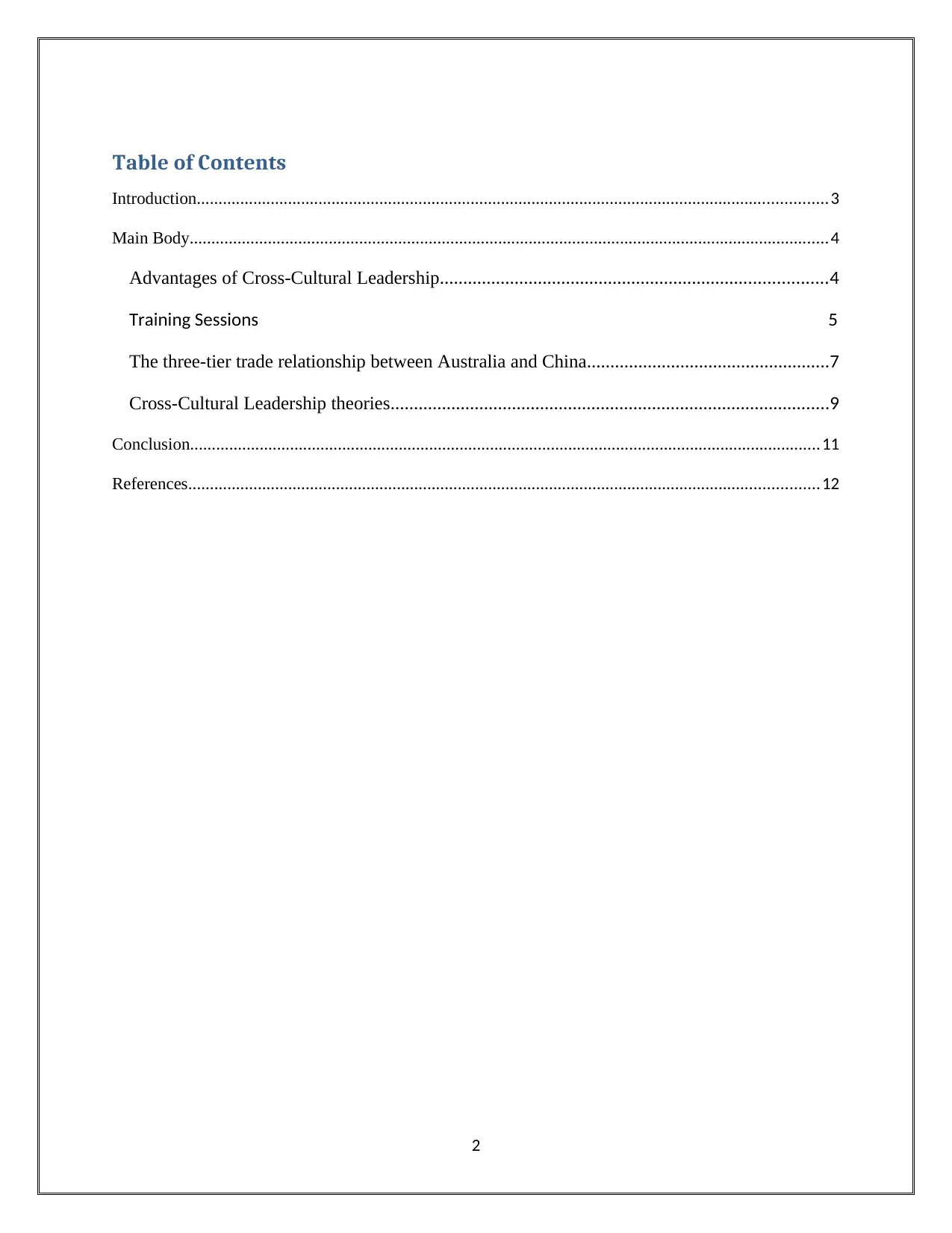
Table of Contents
Introduction.................................................................................................................................................3
Main Body...................................................................................................................................................4
Advantages of Cross-Cultural Leadership...................................................................................4
Training Sessions 5
The three-tier trade relationship between Australia and China....................................................7
Cross-Cultural Leadership theories..............................................................................................9
Conclusion.................................................................................................................................................11
References.................................................................................................................................................12
2
Introduction.................................................................................................................................................3
Main Body...................................................................................................................................................4
Advantages of Cross-Cultural Leadership...................................................................................4
Training Sessions 5
The three-tier trade relationship between Australia and China....................................................7
Cross-Cultural Leadership theories..............................................................................................9
Conclusion.................................................................................................................................................11
References.................................................................................................................................................12
2
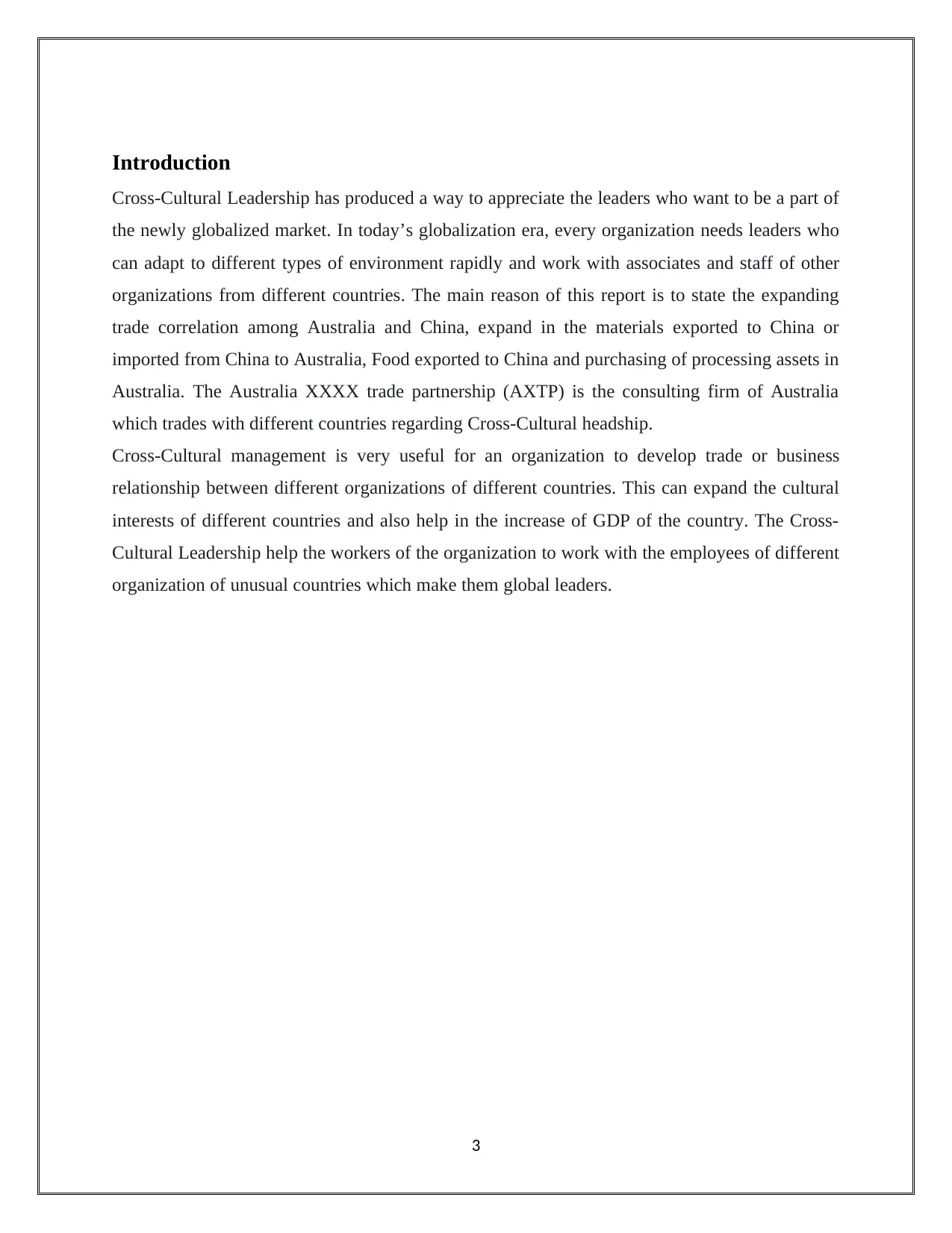
Introduction
Cross-Cultural Leadership has produced a way to appreciate the leaders who want to be a part of
the newly globalized market. In today’s globalization era, every organization needs leaders who
can adapt to different types of environment rapidly and work with associates and staff of other
organizations from different countries. The main reason of this report is to state the expanding
trade correlation among Australia and China, expand in the materials exported to China or
imported from China to Australia, Food exported to China and purchasing of processing assets in
Australia. The Australia XXXX trade partnership (AXTP) is the consulting firm of Australia
which trades with different countries regarding Cross-Cultural headship.
Cross-Cultural management is very useful for an organization to develop trade or business
relationship between different organizations of different countries. This can expand the cultural
interests of different countries and also help in the increase of GDP of the country. The Cross-
Cultural Leadership help the workers of the organization to work with the employees of different
organization of unusual countries which make them global leaders.
3
Cross-Cultural Leadership has produced a way to appreciate the leaders who want to be a part of
the newly globalized market. In today’s globalization era, every organization needs leaders who
can adapt to different types of environment rapidly and work with associates and staff of other
organizations from different countries. The main reason of this report is to state the expanding
trade correlation among Australia and China, expand in the materials exported to China or
imported from China to Australia, Food exported to China and purchasing of processing assets in
Australia. The Australia XXXX trade partnership (AXTP) is the consulting firm of Australia
which trades with different countries regarding Cross-Cultural headship.
Cross-Cultural management is very useful for an organization to develop trade or business
relationship between different organizations of different countries. This can expand the cultural
interests of different countries and also help in the increase of GDP of the country. The Cross-
Cultural Leadership help the workers of the organization to work with the employees of different
organization of unusual countries which make them global leaders.
3
⊘ This is a preview!⊘
Do you want full access?
Subscribe today to unlock all pages.

Trusted by 1+ million students worldwide
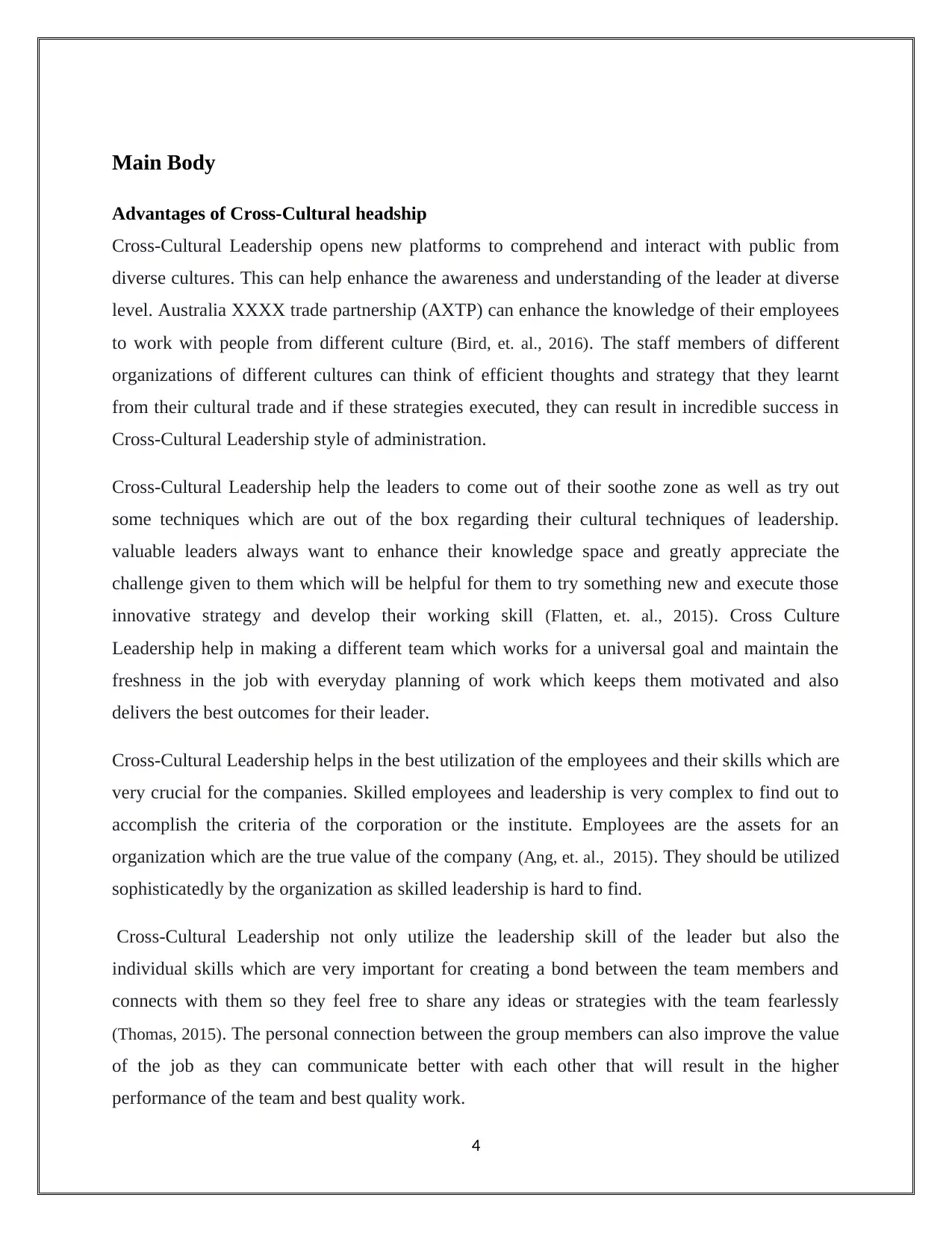
Main Body
Advantages of Cross-Cultural headship
Cross-Cultural Leadership opens new platforms to comprehend and interact with public from
diverse cultures. This can help enhance the awareness and understanding of the leader at diverse
level. Australia XXXX trade partnership (AXTP) can enhance the knowledge of their employees
to work with people from different culture (Bird, et. al., 2016). The staff members of different
organizations of different cultures can think of efficient thoughts and strategy that they learnt
from their cultural trade and if these strategies executed, they can result in incredible success in
Cross-Cultural Leadership style of administration.
Cross-Cultural Leadership help the leaders to come out of their soothe zone as well as try out
some techniques which are out of the box regarding their cultural techniques of leadership.
valuable leaders always want to enhance their knowledge space and greatly appreciate the
challenge given to them which will be helpful for them to try something new and execute those
innovative strategy and develop their working skill (Flatten, et. al., 2015). Cross Culture
Leadership help in making a different team which works for a universal goal and maintain the
freshness in the job with everyday planning of work which keeps them motivated and also
delivers the best outcomes for their leader.
Cross-Cultural Leadership helps in the best utilization of the employees and their skills which are
very crucial for the companies. Skilled employees and leadership is very complex to find out to
accomplish the criteria of the corporation or the institute. Employees are the assets for an
organization which are the true value of the company (Ang, et. al., 2015). They should be utilized
sophisticatedly by the organization as skilled leadership is hard to find.
Cross-Cultural Leadership not only utilize the leadership skill of the leader but also the
individual skills which are very important for creating a bond between the team members and
connects with them so they feel free to share any ideas or strategies with the team fearlessly
(Thomas, 2015). The personal connection between the group members can also improve the value
of the job as they can communicate better with each other that will result in the higher
performance of the team and best quality work.
4
Advantages of Cross-Cultural headship
Cross-Cultural Leadership opens new platforms to comprehend and interact with public from
diverse cultures. This can help enhance the awareness and understanding of the leader at diverse
level. Australia XXXX trade partnership (AXTP) can enhance the knowledge of their employees
to work with people from different culture (Bird, et. al., 2016). The staff members of different
organizations of different cultures can think of efficient thoughts and strategy that they learnt
from their cultural trade and if these strategies executed, they can result in incredible success in
Cross-Cultural Leadership style of administration.
Cross-Cultural Leadership help the leaders to come out of their soothe zone as well as try out
some techniques which are out of the box regarding their cultural techniques of leadership.
valuable leaders always want to enhance their knowledge space and greatly appreciate the
challenge given to them which will be helpful for them to try something new and execute those
innovative strategy and develop their working skill (Flatten, et. al., 2015). Cross Culture
Leadership help in making a different team which works for a universal goal and maintain the
freshness in the job with everyday planning of work which keeps them motivated and also
delivers the best outcomes for their leader.
Cross-Cultural Leadership helps in the best utilization of the employees and their skills which are
very crucial for the companies. Skilled employees and leadership is very complex to find out to
accomplish the criteria of the corporation or the institute. Employees are the assets for an
organization which are the true value of the company (Ang, et. al., 2015). They should be utilized
sophisticatedly by the organization as skilled leadership is hard to find.
Cross-Cultural Leadership not only utilize the leadership skill of the leader but also the
individual skills which are very important for creating a bond between the team members and
connects with them so they feel free to share any ideas or strategies with the team fearlessly
(Thomas, 2015). The personal connection between the group members can also improve the value
of the job as they can communicate better with each other that will result in the higher
performance of the team and best quality work.
4
Paraphrase This Document
Need a fresh take? Get an instant paraphrase of this document with our AI Paraphraser

5
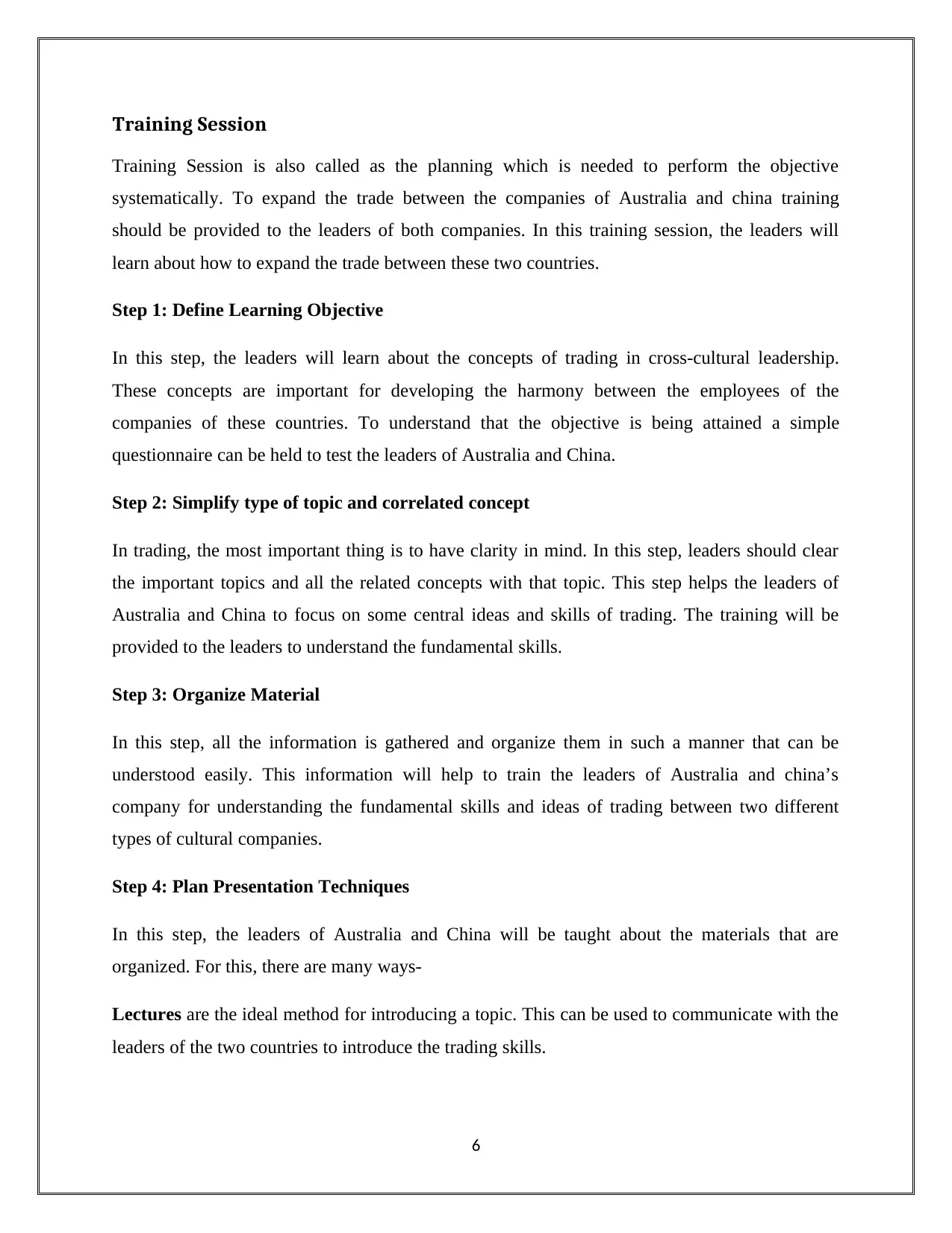
Training Session
Training Session is also called as the planning which is needed to perform the objective
systematically. To expand the trade between the companies of Australia and china training
should be provided to the leaders of both companies. In this training session, the leaders will
learn about how to expand the trade between these two countries.
Step 1: Define Learning Objective
In this step, the leaders will learn about the concepts of trading in cross-cultural leadership.
These concepts are important for developing the harmony between the employees of the
companies of these countries. To understand that the objective is being attained a simple
questionnaire can be held to test the leaders of Australia and China.
Step 2: Simplify type of topic and correlated concept
In trading, the most important thing is to have clarity in mind. In this step, leaders should clear
the important topics and all the related concepts with that topic. This step helps the leaders of
Australia and China to focus on some central ideas and skills of trading. The training will be
provided to the leaders to understand the fundamental skills.
Step 3: Organize Material
In this step, all the information is gathered and organize them in such a manner that can be
understood easily. This information will help to train the leaders of Australia and china’s
company for understanding the fundamental skills and ideas of trading between two different
types of cultural companies.
Step 4: Plan Presentation Techniques
In this step, the leaders of Australia and China will be taught about the materials that are
organized. For this, there are many ways-
Lectures are the ideal method for introducing a topic. This can be used to communicate with the
leaders of the two countries to introduce the trading skills.
6
Training Session is also called as the planning which is needed to perform the objective
systematically. To expand the trade between the companies of Australia and china training
should be provided to the leaders of both companies. In this training session, the leaders will
learn about how to expand the trade between these two countries.
Step 1: Define Learning Objective
In this step, the leaders will learn about the concepts of trading in cross-cultural leadership.
These concepts are important for developing the harmony between the employees of the
companies of these countries. To understand that the objective is being attained a simple
questionnaire can be held to test the leaders of Australia and China.
Step 2: Simplify type of topic and correlated concept
In trading, the most important thing is to have clarity in mind. In this step, leaders should clear
the important topics and all the related concepts with that topic. This step helps the leaders of
Australia and China to focus on some central ideas and skills of trading. The training will be
provided to the leaders to understand the fundamental skills.
Step 3: Organize Material
In this step, all the information is gathered and organize them in such a manner that can be
understood easily. This information will help to train the leaders of Australia and china’s
company for understanding the fundamental skills and ideas of trading between two different
types of cultural companies.
Step 4: Plan Presentation Techniques
In this step, the leaders of Australia and China will be taught about the materials that are
organized. For this, there are many ways-
Lectures are the ideal method for introducing a topic. This can be used to communicate with the
leaders of the two countries to introduce the trading skills.
6
⊘ This is a preview!⊘
Do you want full access?
Subscribe today to unlock all pages.

Trusted by 1+ million students worldwide
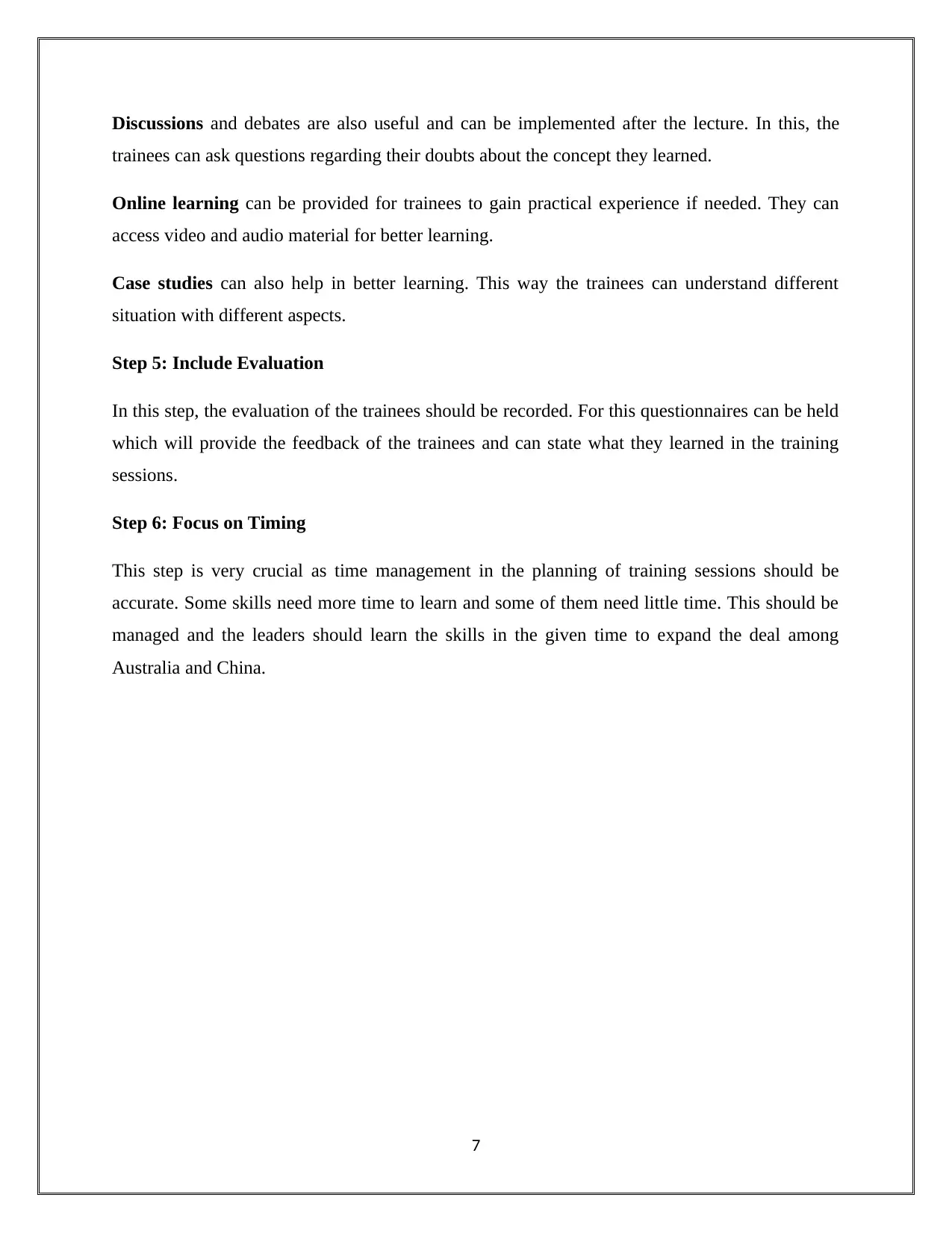
Discussions and debates are also useful and can be implemented after the lecture. In this, the
trainees can ask questions regarding their doubts about the concept they learned.
Online learning can be provided for trainees to gain practical experience if needed. They can
access video and audio material for better learning.
Case studies can also help in better learning. This way the trainees can understand different
situation with different aspects.
Step 5: Include Evaluation
In this step, the evaluation of the trainees should be recorded. For this questionnaires can be held
which will provide the feedback of the trainees and can state what they learned in the training
sessions.
Step 6: Focus on Timing
This step is very crucial as time management in the planning of training sessions should be
accurate. Some skills need more time to learn and some of them need little time. This should be
managed and the leaders should learn the skills in the given time to expand the deal among
Australia and China.
7
trainees can ask questions regarding their doubts about the concept they learned.
Online learning can be provided for trainees to gain practical experience if needed. They can
access video and audio material for better learning.
Case studies can also help in better learning. This way the trainees can understand different
situation with different aspects.
Step 5: Include Evaluation
In this step, the evaluation of the trainees should be recorded. For this questionnaires can be held
which will provide the feedback of the trainees and can state what they learned in the training
sessions.
Step 6: Focus on Timing
This step is very crucial as time management in the planning of training sessions should be
accurate. Some skills need more time to learn and some of them need little time. This should be
managed and the leaders should learn the skills in the given time to expand the deal among
Australia and China.
7
Paraphrase This Document
Need a fresh take? Get an instant paraphrase of this document with our AI Paraphraser
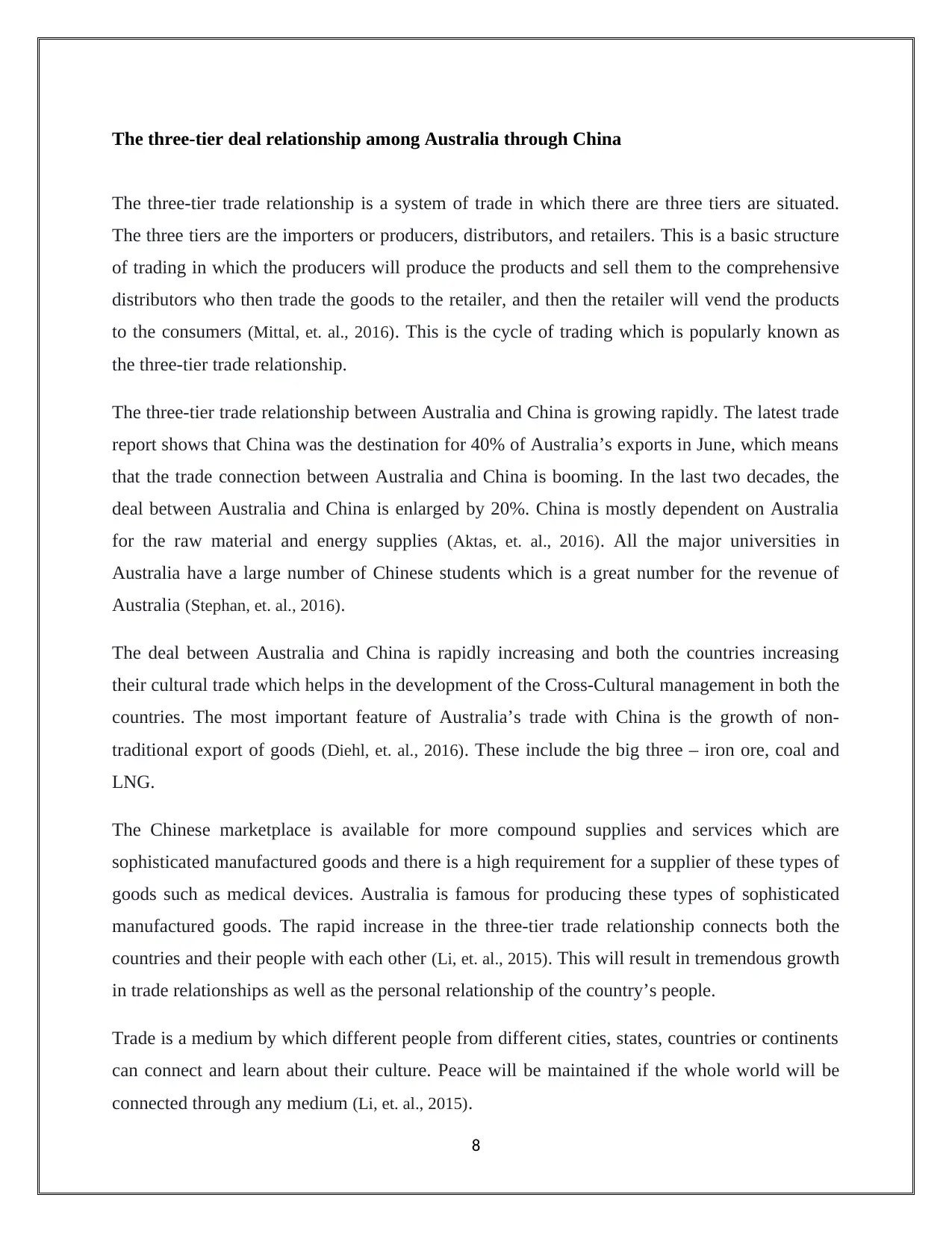
The three-tier deal relationship among Australia through China
The three-tier trade relationship is a system of trade in which there are three tiers are situated.
The three tiers are the importers or producers, distributors, and retailers. This is a basic structure
of trading in which the producers will produce the products and sell them to the comprehensive
distributors who then trade the goods to the retailer, and then the retailer will vend the products
to the consumers (Mittal, et. al., 2016). This is the cycle of trading which is popularly known as
the three-tier trade relationship.
The three-tier trade relationship between Australia and China is growing rapidly. The latest trade
report shows that China was the destination for 40% of Australia’s exports in June, which means
that the trade connection between Australia and China is booming. In the last two decades, the
deal between Australia and China is enlarged by 20%. China is mostly dependent on Australia
for the raw material and energy supplies (Aktas, et. al., 2016). All the major universities in
Australia have a large number of Chinese students which is a great number for the revenue of
Australia (Stephan, et. al., 2016).
The deal between Australia and China is rapidly increasing and both the countries increasing
their cultural trade which helps in the development of the Cross-Cultural management in both the
countries. The most important feature of Australia’s trade with China is the growth of non-
traditional export of goods (Diehl, et. al., 2016). These include the big three – iron ore, coal and
LNG.
The Chinese marketplace is available for more compound supplies and services which are
sophisticated manufactured goods and there is a high requirement for a supplier of these types of
goods such as medical devices. Australia is famous for producing these types of sophisticated
manufactured goods. The rapid increase in the three-tier trade relationship connects both the
countries and their people with each other (Li, et. al., 2015). This will result in tremendous growth
in trade relationships as well as the personal relationship of the country’s people.
Trade is a medium by which different people from different cities, states, countries or continents
can connect and learn about their culture. Peace will be maintained if the whole world will be
connected through any medium (Li, et. al., 2015).
8
The three-tier trade relationship is a system of trade in which there are three tiers are situated.
The three tiers are the importers or producers, distributors, and retailers. This is a basic structure
of trading in which the producers will produce the products and sell them to the comprehensive
distributors who then trade the goods to the retailer, and then the retailer will vend the products
to the consumers (Mittal, et. al., 2016). This is the cycle of trading which is popularly known as
the three-tier trade relationship.
The three-tier trade relationship between Australia and China is growing rapidly. The latest trade
report shows that China was the destination for 40% of Australia’s exports in June, which means
that the trade connection between Australia and China is booming. In the last two decades, the
deal between Australia and China is enlarged by 20%. China is mostly dependent on Australia
for the raw material and energy supplies (Aktas, et. al., 2016). All the major universities in
Australia have a large number of Chinese students which is a great number for the revenue of
Australia (Stephan, et. al., 2016).
The deal between Australia and China is rapidly increasing and both the countries increasing
their cultural trade which helps in the development of the Cross-Cultural management in both the
countries. The most important feature of Australia’s trade with China is the growth of non-
traditional export of goods (Diehl, et. al., 2016). These include the big three – iron ore, coal and
LNG.
The Chinese marketplace is available for more compound supplies and services which are
sophisticated manufactured goods and there is a high requirement for a supplier of these types of
goods such as medical devices. Australia is famous for producing these types of sophisticated
manufactured goods. The rapid increase in the three-tier trade relationship connects both the
countries and their people with each other (Li, et. al., 2015). This will result in tremendous growth
in trade relationships as well as the personal relationship of the country’s people.
Trade is a medium by which different people from different cities, states, countries or continents
can connect and learn about their culture. Peace will be maintained if the whole world will be
connected through any medium (Li, et. al., 2015).
8
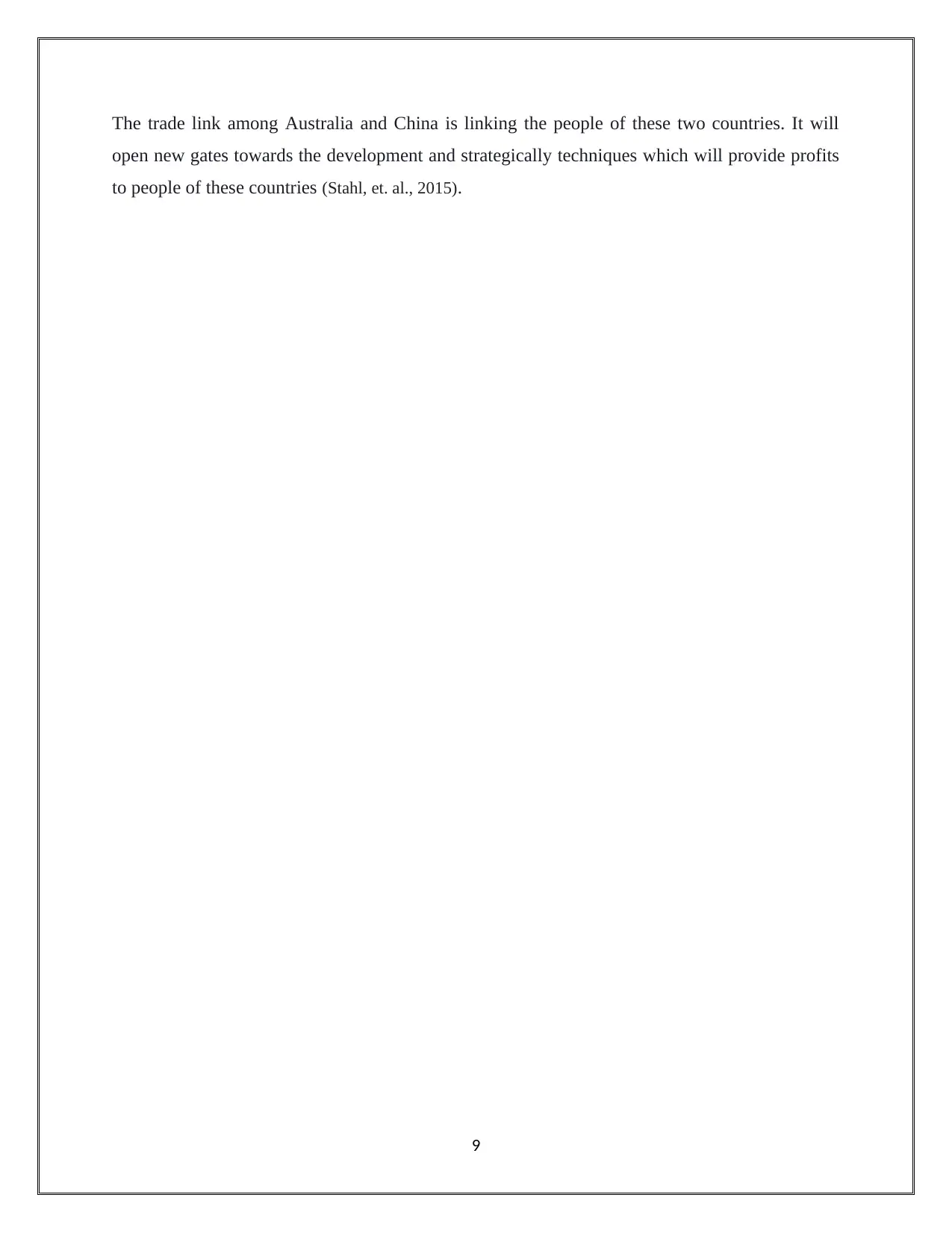
The trade link among Australia and China is linking the people of these two countries. It will
open new gates towards the development and strategically techniques which will provide profits
to people of these countries (Stahl, et. al., 2015).
9
open new gates towards the development and strategically techniques which will provide profits
to people of these countries (Stahl, et. al., 2015).
9
⊘ This is a preview!⊘
Do you want full access?
Subscribe today to unlock all pages.

Trusted by 1+ million students worldwide
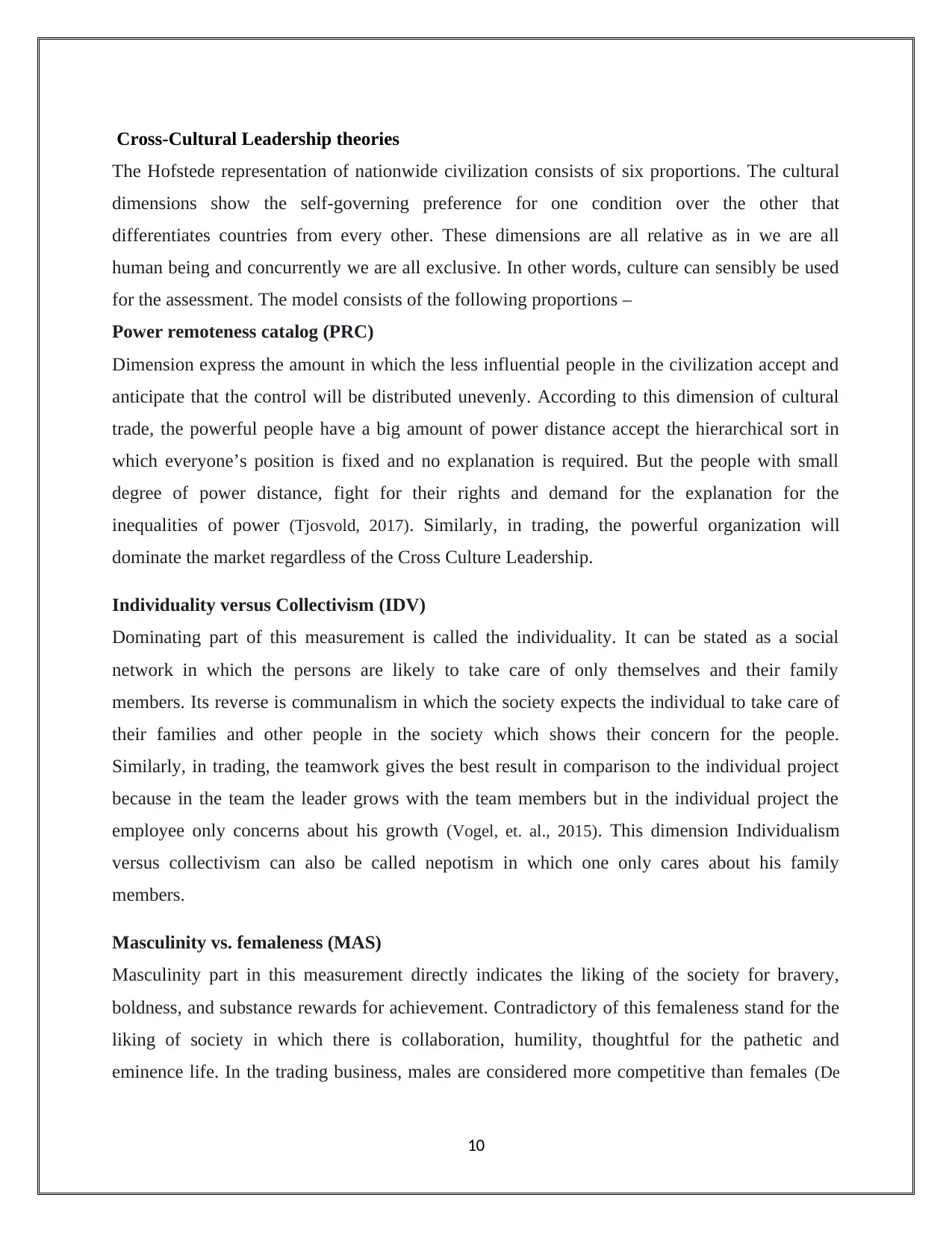
Cross-Cultural Leadership theories
The Hofstede representation of nationwide civilization consists of six proportions. The cultural
dimensions show the self-governing preference for one condition over the other that
differentiates countries from every other. These dimensions are all relative as in we are all
human being and concurrently we are all exclusive. In other words, culture can sensibly be used
for the assessment. The model consists of the following proportions –
Power remoteness catalog (PRC)
Dimension express the amount in which the less influential people in the civilization accept and
anticipate that the control will be distributed unevenly. According to this dimension of cultural
trade, the powerful people have a big amount of power distance accept the hierarchical sort in
which everyone’s position is fixed and no explanation is required. But the people with small
degree of power distance, fight for their rights and demand for the explanation for the
inequalities of power (Tjosvold, 2017). Similarly, in trading, the powerful organization will
dominate the market regardless of the Cross Culture Leadership.
Individuality versus Collectivism (IDV)
Dominating part of this measurement is called the individuality. It can be stated as a social
network in which the persons are likely to take care of only themselves and their family
members. Its reverse is communalism in which the society expects the individual to take care of
their families and other people in the society which shows their concern for the people.
Similarly, in trading, the teamwork gives the best result in comparison to the individual project
because in the team the leader grows with the team members but in the individual project the
employee only concerns about his growth (Vogel, et. al., 2015). This dimension Individualism
versus collectivism can also be called nepotism in which one only cares about his family
members.
Masculinity vs. femaleness (MAS)
Masculinity part in this measurement directly indicates the liking of the society for bravery,
boldness, and substance rewards for achievement. Contradictory of this femaleness stand for the
liking of society in which there is collaboration, humility, thoughtful for the pathetic and
eminence life. In the trading business, males are considered more competitive than females (De
10
The Hofstede representation of nationwide civilization consists of six proportions. The cultural
dimensions show the self-governing preference for one condition over the other that
differentiates countries from every other. These dimensions are all relative as in we are all
human being and concurrently we are all exclusive. In other words, culture can sensibly be used
for the assessment. The model consists of the following proportions –
Power remoteness catalog (PRC)
Dimension express the amount in which the less influential people in the civilization accept and
anticipate that the control will be distributed unevenly. According to this dimension of cultural
trade, the powerful people have a big amount of power distance accept the hierarchical sort in
which everyone’s position is fixed and no explanation is required. But the people with small
degree of power distance, fight for their rights and demand for the explanation for the
inequalities of power (Tjosvold, 2017). Similarly, in trading, the powerful organization will
dominate the market regardless of the Cross Culture Leadership.
Individuality versus Collectivism (IDV)
Dominating part of this measurement is called the individuality. It can be stated as a social
network in which the persons are likely to take care of only themselves and their family
members. Its reverse is communalism in which the society expects the individual to take care of
their families and other people in the society which shows their concern for the people.
Similarly, in trading, the teamwork gives the best result in comparison to the individual project
because in the team the leader grows with the team members but in the individual project the
employee only concerns about his growth (Vogel, et. al., 2015). This dimension Individualism
versus collectivism can also be called nepotism in which one only cares about his family
members.
Masculinity vs. femaleness (MAS)
Masculinity part in this measurement directly indicates the liking of the society for bravery,
boldness, and substance rewards for achievement. Contradictory of this femaleness stand for the
liking of society in which there is collaboration, humility, thoughtful for the pathetic and
eminence life. In the trading business, males are considered more competitive than females (De
10
Paraphrase This Document
Need a fresh take? Get an instant paraphrase of this document with our AI Paraphraser
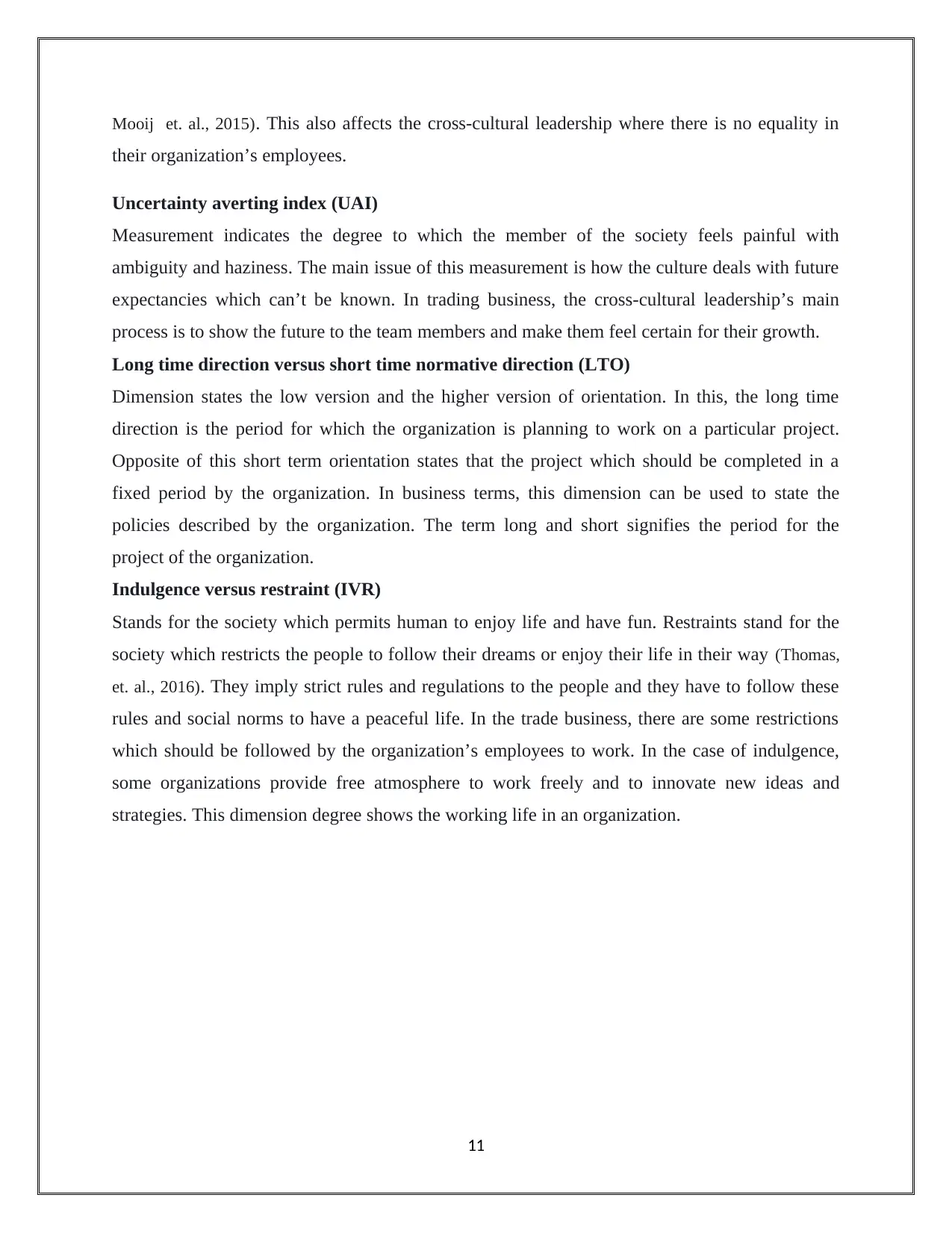
Mooij et. al., 2015). This also affects the cross-cultural leadership where there is no equality in
their organization’s employees.
Uncertainty averting index (UAI)
Measurement indicates the degree to which the member of the society feels painful with
ambiguity and haziness. The main issue of this measurement is how the culture deals with future
expectancies which can’t be known. In trading business, the cross-cultural leadership’s main
process is to show the future to the team members and make them feel certain for their growth.
Long time direction versus short time normative direction (LTO)
Dimension states the low version and the higher version of orientation. In this, the long time
direction is the period for which the organization is planning to work on a particular project.
Opposite of this short term orientation states that the project which should be completed in a
fixed period by the organization. In business terms, this dimension can be used to state the
policies described by the organization. The term long and short signifies the period for the
project of the organization.
Indulgence versus restraint (IVR)
Stands for the society which permits human to enjoy life and have fun. Restraints stand for the
society which restricts the people to follow their dreams or enjoy their life in their way (Thomas,
et. al., 2016). They imply strict rules and regulations to the people and they have to follow these
rules and social norms to have a peaceful life. In the trade business, there are some restrictions
which should be followed by the organization’s employees to work. In the case of indulgence,
some organizations provide free atmosphere to work freely and to innovate new ideas and
strategies. This dimension degree shows the working life in an organization.
11
their organization’s employees.
Uncertainty averting index (UAI)
Measurement indicates the degree to which the member of the society feels painful with
ambiguity and haziness. The main issue of this measurement is how the culture deals with future
expectancies which can’t be known. In trading business, the cross-cultural leadership’s main
process is to show the future to the team members and make them feel certain for their growth.
Long time direction versus short time normative direction (LTO)
Dimension states the low version and the higher version of orientation. In this, the long time
direction is the period for which the organization is planning to work on a particular project.
Opposite of this short term orientation states that the project which should be completed in a
fixed period by the organization. In business terms, this dimension can be used to state the
policies described by the organization. The term long and short signifies the period for the
project of the organization.
Indulgence versus restraint (IVR)
Stands for the society which permits human to enjoy life and have fun. Restraints stand for the
society which restricts the people to follow their dreams or enjoy their life in their way (Thomas,
et. al., 2016). They imply strict rules and regulations to the people and they have to follow these
rules and social norms to have a peaceful life. In the trade business, there are some restrictions
which should be followed by the organization’s employees to work. In the case of indulgence,
some organizations provide free atmosphere to work freely and to innovate new ideas and
strategies. This dimension degree shows the working life in an organization.
11
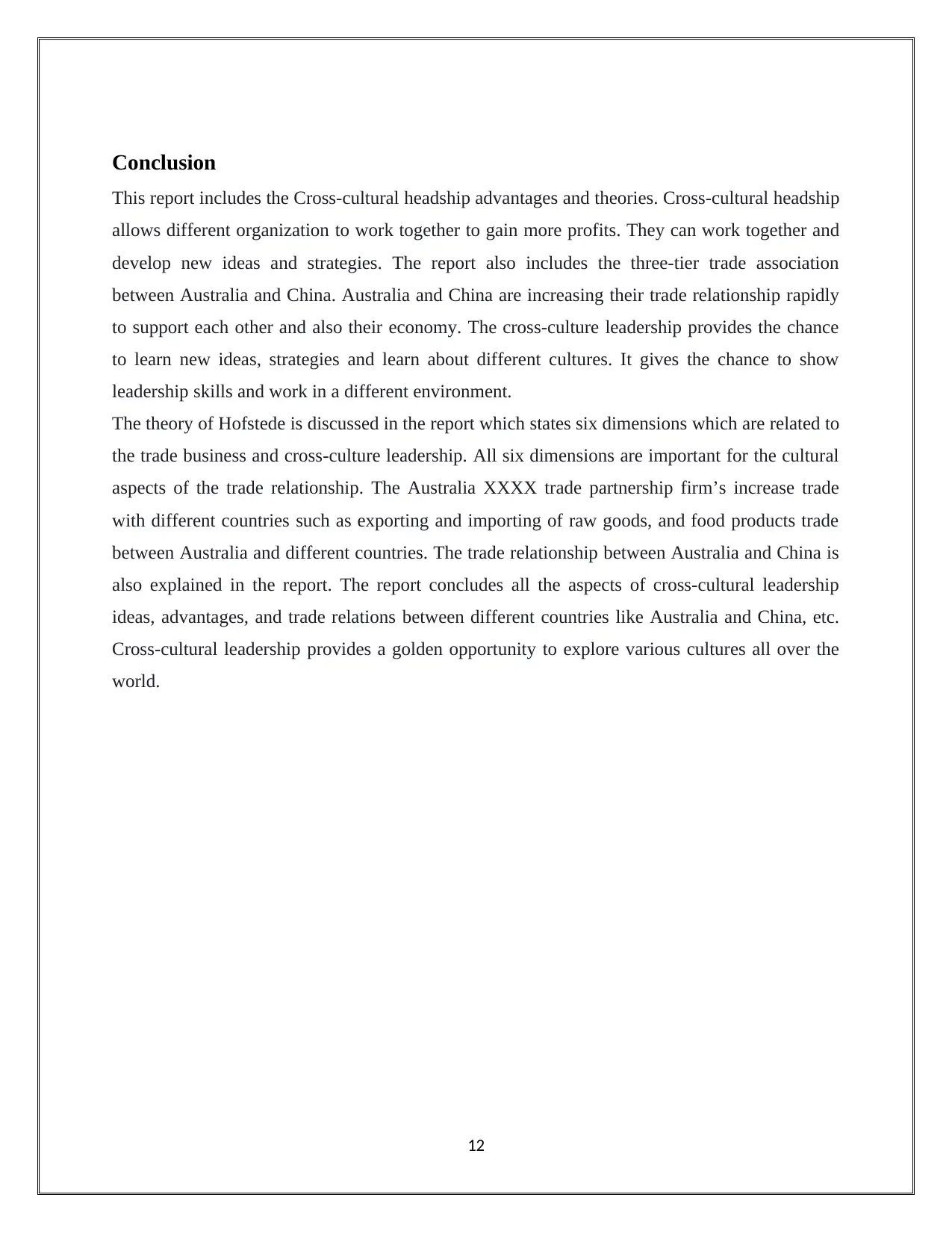
Conclusion
This report includes the Cross-cultural headship advantages and theories. Cross-cultural headship
allows different organization to work together to gain more profits. They can work together and
develop new ideas and strategies. The report also includes the three-tier trade association
between Australia and China. Australia and China are increasing their trade relationship rapidly
to support each other and also their economy. The cross-culture leadership provides the chance
to learn new ideas, strategies and learn about different cultures. It gives the chance to show
leadership skills and work in a different environment.
The theory of Hofstede is discussed in the report which states six dimensions which are related to
the trade business and cross-culture leadership. All six dimensions are important for the cultural
aspects of the trade relationship. The Australia XXXX trade partnership firm’s increase trade
with different countries such as exporting and importing of raw goods, and food products trade
between Australia and different countries. The trade relationship between Australia and China is
also explained in the report. The report concludes all the aspects of cross-cultural leadership
ideas, advantages, and trade relations between different countries like Australia and China, etc.
Cross-cultural leadership provides a golden opportunity to explore various cultures all over the
world.
12
This report includes the Cross-cultural headship advantages and theories. Cross-cultural headship
allows different organization to work together to gain more profits. They can work together and
develop new ideas and strategies. The report also includes the three-tier trade association
between Australia and China. Australia and China are increasing their trade relationship rapidly
to support each other and also their economy. The cross-culture leadership provides the chance
to learn new ideas, strategies and learn about different cultures. It gives the chance to show
leadership skills and work in a different environment.
The theory of Hofstede is discussed in the report which states six dimensions which are related to
the trade business and cross-culture leadership. All six dimensions are important for the cultural
aspects of the trade relationship. The Australia XXXX trade partnership firm’s increase trade
with different countries such as exporting and importing of raw goods, and food products trade
between Australia and different countries. The trade relationship between Australia and China is
also explained in the report. The report concludes all the aspects of cross-cultural leadership
ideas, advantages, and trade relations between different countries like Australia and China, etc.
Cross-cultural leadership provides a golden opportunity to explore various cultures all over the
world.
12
⊘ This is a preview!⊘
Do you want full access?
Subscribe today to unlock all pages.

Trusted by 1+ million students worldwide
1 out of 14
Related Documents
Your All-in-One AI-Powered Toolkit for Academic Success.
+13062052269
info@desklib.com
Available 24*7 on WhatsApp / Email
![[object Object]](/_next/static/media/star-bottom.7253800d.svg)
Unlock your academic potential
Copyright © 2020–2025 A2Z Services. All Rights Reserved. Developed and managed by ZUCOL.





